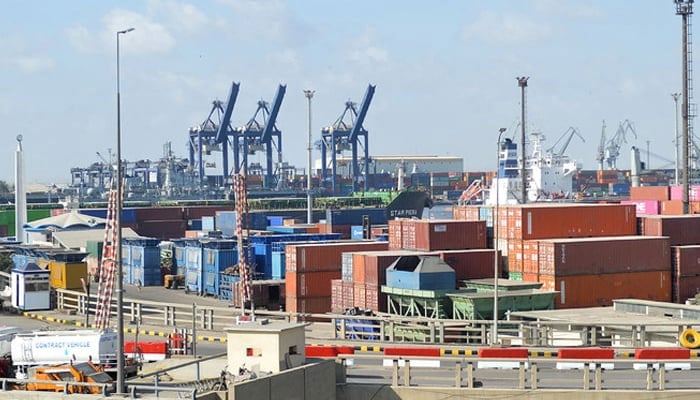What economic challenges loom ahead?
Low baseline impact boosts export volumes (mainly rice), but reduction in export unit value raises questions
As Pakistan is getting ready to usher in a new government, the nation's economic trajectory is a focus of attention. The question that looms is whether the change of guard in Islamabad can truly steer Pakistan's economy out of its challenges or if the perils persist despite recent promising macroeconomic indicators that reflect a positive trend compared to the previous year.
During the last few months, fiscal consolidation maintained its course, foreign exchange buffers improved, and the current account deficit narrowed, suggesting a robust economic foundation. Yet, a closer look reveals the undercurrent complexities and uncertainties.
For instance, take the example of headline inflation (including energy and food prices). It has receded from 38 per cent to around 30 per cent from May 2023 to January 2024. However, substantial energy price adjustments (including the latest increase of Rs7 per unit in the electricity tariff) pose a challenge to disinflation. The precarious global energy market, marked by disruptions in the Red Sea supply route, adds additional risk. Any hike in global fuel prices will escalate inflation in Pakistan.
Likewise, the government's pledge to reduce food prices hinges on factors such as weather conditions and the ability of provincial governments to curb hoarding and profiteering. Initiatives like the establishment of a dedicated department for price control by the new chief minister of Punjab indicate a proactive approach. One hopes such initiatives will be replicated by other provinces, too. However, the actual relief from food inflation depends on the success of such measures.
While positive strides in exports compared to the previous fiscal year offer a glimmer of hope, concerns arise when analyzing the contributing factors. The low baseline impact boosts export volumes (mainly rice), but the reduction in export unit value raises questions. Notably, high-value-added textile exports continue to struggle, presenting a nuanced picture of the export landscape. A decline in imports, contributing to an improved trade balance, masks a lacklustre recovery in the manufacturing sector, grappling with high energy tariffs and interest rates.
Energy tariffs seem to continue to haunt Pakistan’s manufacturing sector (and the residential customers) throughout 2024. It is a fact that energy circular debt (ECD), which has already touched Rs5.7 trillion, should be contained and reduced. However, increasing tariffs is not the only solution for it. The National Electric Power Regulatory Authority's (Nepra) latest performance evaluation report of electricity distribution companies (DISCOs) is an eye-opener.
The report reveals staggering losses by DISCOs in 2022-23 (Rs166 billion as transmission and distribution losses and Rs263 billion in losses through non-collection of bills). For comparison, the losses by DISCOs during the last fiscal year are equivalent to BISP’s annual allocation for social safety nets. Minimizing DISCOs' losses can help contain ECD and create fiscal space for an additional budget for BISP.
The buoyancy in workers' remittances during the last quarter is encouraging, but shadows loom over its sustainability. Visa restrictions for Pakistani workers in the Gulf countries (especially in Saudi Arabia and the UAE), coupled with constraints on changing employers (restrictions on ‘the ‘Azad visa’), and deportations pose challenges. The new government will have to use its acumen with the Gulf rulers to negotiate a favourable visa regime for Pakistani workers.
The FBR's commendable revenue growth, while impressive at twenty-nine percent from July 2023 to January 2024, loses its lustre when accounting for the thirty percent inflation during this period. Broadening the tax net and improving the quality of taxes (shifting from indirect to direct taxes) is a must for revenue growth in real terms. Successive governments in the past failed to tap the true tax potential of sectors such as real estate, retail, and income on agriculture. How the new government will fare on this front needs to be seen.
While the State Bank of Pakistan's foreign currency reserves show improvement ($8 billion versus $3 billion a year ago), the looming Euro Bonds payment of $1 billion in April 2024 and the necessity for an additional $10 billion by June 2024 for external liabilities underscore the fragility of Pakistan's economic position. Any delay in securing the next International Monetary Fund (IMF) deal could cast a shadow on Pakistan's forex reserves and creditworthiness. One expects that the IMF will link the release of the first tranche of its next program with the upcoming federal budget. Maintaining a critical balance between IMF commitments and electoral promises will be a daunting challenge for the new government. Any policy misstep here may take Pakistan back to the abyss of sovereign default that it narrowly escaped in June 2023.
The list of challenges confronting the incoming government does not end here. Debt management, entwined with economic policies and foreign relations, is at the forefront. A closer look reveals a debt composition where 57.7 per cent is domestic, while 42.3 per cent is external. Unpacking external debt reveals a delicate balance, with loans from China and Chinese commercial creditors surpassing combined loans from the IMF and the World Bank. In a world witnessing growing geopolitical polarization, the new government will have to maintain equally good relations with the Western world and China in pursuit of its debt sustainability.
Besides debt, the new government faces an array of challenges, from reviving or privatizing state-owned enterprises to enhancing GDP-contributing sectors' productivity, rectifying trade imbalances, curbing exchange rate volatility, reducing non-developmental expenditures and addressing deficits – not only fiscal and current account but also the trust deficit with the people of Pakistan and the international community.
However, there are challenges beyond economic balance sheets that, if left unaddressed, could render our society uninhabitable, irrespective of economic recovery. The recent harrowing incident in Lahore, where an innocent woman faced the threat of a mob lynching based on false blasphemy accusations, serves as a chilling reminder. Although the victim was miraculously rescued by the courageous intervention of ASP Sheharbano Naqvi, who risked her own life to save her. Yet the incident underscores the pervasive religious fanaticism in our society. Amidst such insanity, aspirations of attracting foreign investment and curbing brain drain seem utopian.
While economic challenges demand attention, the new government must ensure society remains a safe place to live. Economic issues may find external support, but combating extremism requires more than financial assistance. Adopting a stance of zero tolerance towards hatemongers, fostered under shortsighted policies of the past, is crucial. All stakeholders must recognize that unaddressed extremism poses a threat to everyone, including those fostering it. Balancing economic prosperity with societal security is the true challenge for the new government.
The writer heads the Sustainable Development Policy Institute. He tweets/posts @abidsuleri
-
 Mississippi Postal Worker Arrested After Complaints Of Marijuana Odour In Letters
Mississippi Postal Worker Arrested After Complaints Of Marijuana Odour In Letters -
 Canada, China Lock Initial Trade Deal On ‘EV,Canola’ To Strengthen Ties: What To Expect Next?
Canada, China Lock Initial Trade Deal On ‘EV,Canola’ To Strengthen Ties: What To Expect Next? -
 Melissa Leo On Euphoria Of Winning An Oscar Vs It's Impact On Career
Melissa Leo On Euphoria Of Winning An Oscar Vs It's Impact On Career -
 Meghan Markle, Prince Harry Express 'hope' In Latest Major Statement
Meghan Markle, Prince Harry Express 'hope' In Latest Major Statement -
 Sophie Turner Backs Archie Madekwe As BAFTA Announces Nominees
Sophie Turner Backs Archie Madekwe As BAFTA Announces Nominees -
 Jason Momoa Cherishes Hosting Ozzy Osbourne's Final Gig Ahead Of His Death
Jason Momoa Cherishes Hosting Ozzy Osbourne's Final Gig Ahead Of His Death -
 Real Reason Timothee Chalamet Thanked Kylie Jenner At Awards Revealed
Real Reason Timothee Chalamet Thanked Kylie Jenner At Awards Revealed -
 Will King Charles Attend Funeral Of Prince Philip's First Cousin, Princess Irene?
Will King Charles Attend Funeral Of Prince Philip's First Cousin, Princess Irene? -
 'Furious' Prince William Wants Andrew As Far Away As Possible
'Furious' Prince William Wants Andrew As Far Away As Possible -
 Blood Moon: When And Where To Watch In 2026
Blood Moon: When And Where To Watch In 2026 -
 Apple Foldable IPhone Tipped For 2026 Launch With A20 Pro Chip And C2 Modem
Apple Foldable IPhone Tipped For 2026 Launch With A20 Pro Chip And C2 Modem -
 Meghan Lends Credence To Reports Of Rift With Kim Kardashian On Chicago's Birthday
Meghan Lends Credence To Reports Of Rift With Kim Kardashian On Chicago's Birthday -
 Florida Woman’s Alleged Bid To Bribe Police Ends In Unexpected Discovery
Florida Woman’s Alleged Bid To Bribe Police Ends In Unexpected Discovery -
 James Van Der Beek Strongly Opposes The Idea Of New Year In Winter
James Van Der Beek Strongly Opposes The Idea Of New Year In Winter -
 Elon Musk’s Starlink Rival Eutelsat Partners With MaiaSpace For Satellite Launches
Elon Musk’s Starlink Rival Eutelsat Partners With MaiaSpace For Satellite Launches -
 Fans Feel For Leonardo DiCaprio As He Gets Awkwardly Snubbed: Watch
Fans Feel For Leonardo DiCaprio As He Gets Awkwardly Snubbed: Watch




